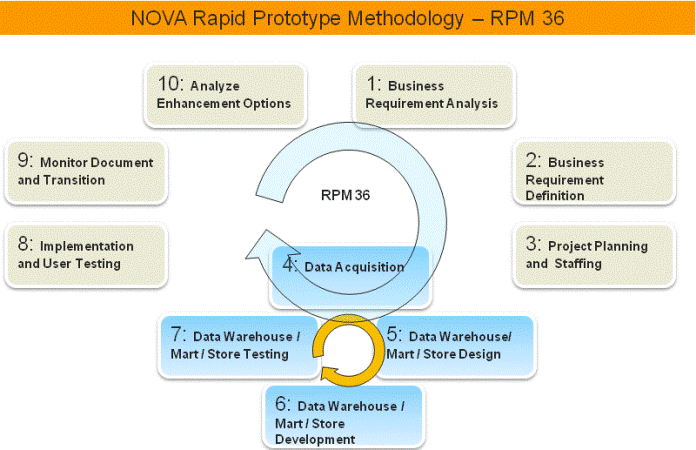BI Implementation Methodology - Rapid Prototype Methodology 3-6 (RPM 36)
Over the years, NOVA's BI Practice has perfected its BI implementation methodology to allow its project managers handle clients' objectives in a logical manner and provide effective and efficient BI Solution. It was observed that within a period of 6 months, most BI solutions required enhancements because of the dynamism in business. So we make it a point to plan and deliver objectives within the 3 to 6 months framework so that our clients realize their ROI throughout the life span of the solution.

BI Architecture
Novasys's BI architecture consists of the following layers:
Data Source Layer
The Data Source layer, as the name suggests, is the interface to various source systems, either through automated bridges or by automated data extraction and transformation process. The data source could be ERP, Legacy Systems or other OLTP systems
Staging Layer
Staging Layer is one where data is extracted, collated and various transformations are performed. Transformed data is ten loaded into the warehouse tables from here.
Data Warehouse / Data Mart Layer
Organizations who would need to analyze different subject areas and compare data across all functional areas, organize data into a Data Warehouse or a Data Mart. This framework eliminates the analysis and reporting load off the OLTP system.
OLAP Layer
This is the analytics layer where complex analytic functions are performed and where multidimensional, repetitive and exception reports are run on subsets of data loaded into the OLAP cube from the data mart or data warehouse.
End User / Presentation Layer
This layer is the interface between the BI backbone and the user. This reporting layer fetches data from either the data warehouse / data mart layer or from the OLAP layer depending on the user interface application. Detailed reports are run off of the warehouse or marts while summarized analytic reports are run off of the OLAP layer.
Over the years, NOVA's BI Practice has perfected its BI implementation methodology to allow its project managers handle clients' objectives in a logical manner and provide effective and efficient BI Solution. It was observed that within a period of 6 months, most BI solutions required enhancements because of the dynamism in business. So we make it a point to plan and deliver objectives within the 3 to 6 months framework so that our clients realize their ROI throughout the life span of the solution.

BI Architecture
Novasys's BI architecture consists of the following layers:
Data Source Layer
The Data Source layer, as the name suggests, is the interface to various source systems, either through automated bridges or by automated data extraction and transformation process. The data source could be ERP, Legacy Systems or other OLTP systems
Staging Layer
Staging Layer is one where data is extracted, collated and various transformations are performed. Transformed data is ten loaded into the warehouse tables from here.
Data Warehouse / Data Mart Layer
Organizations who would need to analyze different subject areas and compare data across all functional areas, organize data into a Data Warehouse or a Data Mart. This framework eliminates the analysis and reporting load off the OLTP system.
OLAP Layer
This is the analytics layer where complex analytic functions are performed and where multidimensional, repetitive and exception reports are run on subsets of data loaded into the OLAP cube from the data mart or data warehouse.
End User / Presentation Layer
This layer is the interface between the BI backbone and the user. This reporting layer fetches data from either the data warehouse / data mart layer or from the OLAP layer depending on the user interface application. Detailed reports are run off of the warehouse or marts while summarized analytic reports are run off of the OLAP layer.
|
|
|



